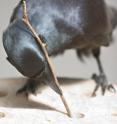Foraging for fat: Crafty crows use tools to fish for nutritious morsels
Tool use is so rare in the animal kingdom that it was once believed to be a uniquely human trait. While it is now known that some non-human animal species can use tools for foraging, the rarity of this behaviour remains a puzzle. It is generally assumed that tool use played a key role in human evolution, so understanding this behaviour's ecological context, and its evolutionary roots, is of major scientific interest. A project led by researchers from the Universities of Oxford and Exeter examined the ecological significance of tool use in New Caledonian crows, a species renowned for its sophisticated tool-use behaviour. The scientists found that a substantial amount of the crows' energy intake comes from tool-derived food, highlighting the nutritional significance of their remarkable tool-use skills. A report of the research appears in this week's Science. To trace the evolutionary origins of specific behaviours, scientists usually compare the ecologies and life histories of those species that exhibit the trait of interest, searching for common patterns and themes. "Unfortunately, this powerful technique cannot be used for studying the evolution of tool use, because there are simply too few species that are known to show this behaviour in the wild," says Dr Christian Rutz from Oxford University's Department of Zoology, who led the project. But, as he explains further, some light can still be shed on this intriguing question. "Examining the ecological context, and adaptive significance, of a species' tool-use behaviour under contemporary conditions can uncover the selection pressures that currently maintain the behaviour, and may even point to those that fostered its evolution in the past. This was the rationale of our study on New Caledonian crows."
Observing New Caledonian crows in the wild, on their home island in the South Pacific, is extremely difficult, because they are easily disturbed and live in densely forested, mountainous terrain. To gather quantitative data on the foraging behaviour and diet composition of individual crows, the scientists came up with an unconventional study approach. New Caledonian crows consume a range of foods, but require tools to extract wood-boring longhorn beetle larvae from their burrows. These larvae, with their unusual diet, have a distinct chemical fingerprint—their stable isotope profile—that can be traced in the crows' feathers and blood, enabling efficient sample collection with little or no harm to the birds. "By comparing the stable isotope profiles of the crows' tissues with those of their putative food sources, we could estimate the proportion of larvae in crow diet, providing a powerful proxy for individual tool-use dependence," explains Dr Rutz.
The analysis of the samples presented further challenges. Dr Stuart Bearhop from Exeter University's School of Biosciences, who led the stable-isotope analyses, points out: "These crows are opportunistic foragers, and eat a range of different foods. The approach we used is very similar to that employed by forensic scientists trying to solve crimes, and has even appeared on CSI. We have developed very powerful statistical models that enabled us to use the unique fingerprints, or stable isotope profiles, of each food type to estimate the amount of beetle larvae consumed by individual New Caledonian crows."
The scientists found that beetle larvae are so energy rich, and full of fat, that just a few specimens can satisfy a crow's daily energy requirements, demonstrating that competent tool users can enjoy substantial rewards. "Our results show that tool use provides New Caledonian crows with access to an extremely profitable food source that is not easily exploited by beak alone," says Dr Rutz. And, Dr Bearhop adds: "This suggests that unusual foraging opportunities on the remote, tropical island of New Caledonia selected for, and currently maintain, these crows' sophisticated tool technology. Other factors have probably played a role, too, but at least we now have a much better understanding of the dietary significance of this remarkable behaviour."
The scientists believe that their novel methodological approach could prove key to investigating in the future whether particularly proficient tool users, with their privileged access to larvae, produce offspring of superior body condition, and whether a larva-rich diet has lasting effects on future survival and reproduction. "The fact that we can estimate the importance of tool use from a small tissue sample opens up exciting possibilities. This approach may even be suitable for studying other animal tool users, like chimpanzees," speculates Dr Rutz.
